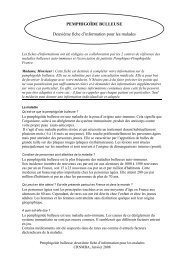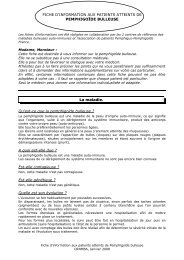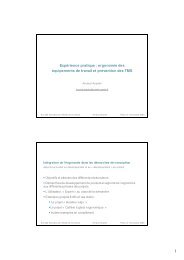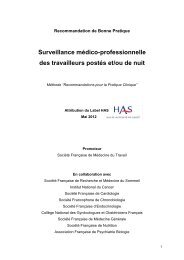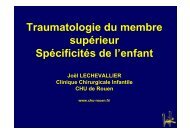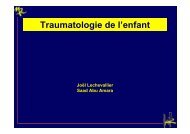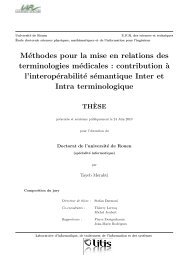Automatic methods for mapping Biomedical ... - CHU de Rouen
Automatic methods for mapping Biomedical ... - CHU de Rouen
Automatic methods for mapping Biomedical ... - CHU de Rouen
You also want an ePaper? Increase the reach of your titles
YUMPU automatically turns print PDFs into web optimized ePapers that Google loves.
<strong>Automatic</strong> <strong>methods</strong> <strong>for</strong> <strong>mapping</strong> <strong>Biomedical</strong> terminologies in<br />
a Health Multi-Terminology Portal<br />
Tayeb Merabti ∗ , Julien Grosjean ∗<br />
Hocine Abdoune ∗∗ Michel Joubert ∗∗ Stefan Darmoni ∗<br />
∗ CISMeF, <strong>Rouen</strong> University Hospital, Normandy &<br />
TIBS, LITIS EA 4108, <strong>Rouen</strong> University Hospital, <strong>Rouen</strong>, France<br />
nom.prenom@chu-rouen.fr,<br />
http://www.cismef.org<br />
∗∗ LERTIM EA 3283, Marseilles, Faculty of Medicine, Marseilles, France<br />
nom.prenom@ap-hm.fr<br />
http://cybertim.timone.univ-mrs.fr<br />
Abstract. Terminology <strong>mapping</strong> is an important and crucial task to improve semantic<br />
interoperability between health care applications and resources. In 2009,<br />
CISMeF created a Health Multi-Terminological Portal (HMTP) to search concepts<br />
among all the health terminologies available in French (or in English and<br />
translated in French) inclu<strong>de</strong>d in this portal and to browse it dynamically. To<br />
map terminologies in the HMTP, two <strong>methods</strong> are used: (1) conceptual method<br />
which exploits various features of the UMLS, (2) lexical method based on natural<br />
language processing in French and English. A total of 199,786 <strong>mapping</strong>s<br />
were per<strong>for</strong>med between at least two French terms using conceptual method,<br />
whereas 266,139 <strong>mapping</strong>s were per<strong>for</strong>med using lexical <strong>methods</strong>. These <strong>mapping</strong>s<br />
were all integrated in the HMTP <strong>de</strong>veloped by CISMeF. Conceptual and<br />
lexical <strong>methods</strong> were used to translate some English terminologies into French<br />
such as MEDLINEPlus, FMA and SNOMED CT.<br />
1 Introduction<br />
<strong>Biomedical</strong> terminologies and ontologies have proliferated during the past <strong>de</strong>ca<strong>de</strong>. Due to<br />
this proliferation, different health care systems use different biomedical terminologies. In this<br />
context, tools and <strong>methods</strong> to map biomedical terminologies are nee<strong>de</strong>d to solve data interoperability<br />
problems. The process of terminology <strong>mapping</strong> consists of i<strong>de</strong>ntifying relationships<br />
or i<strong>de</strong>ntical (or approximately i<strong>de</strong>ntical) concepts between terminologies Wang et al. (2008).<br />
Various research teams have investigated automatic <strong>methods</strong> to produce high-quality <strong>mapping</strong>s<br />
between terminologies Rocha et al. (1994); Fung and Bo<strong>de</strong>nrei<strong>de</strong>r (2005); Bo<strong>de</strong>nrei<strong>de</strong>r<br />
et al. (1998); Merabti et al. (2010b). The objective of this paper is to <strong>de</strong>scribe two types of<br />
approaches to map biomedical terminologies in English and French whether or not inclu<strong>de</strong>d<br />
into Unified Medical Language System (UMLS)Lindberg et al. (1993). These two approaches<br />
are currently implemented into a Health Multi-Terminological Portal (HMTP)Darmoni et al.<br />
(2010) <strong>de</strong>veloped by the CISMeF team Darmoni et al. (2000).
<strong>Automatic</strong> <strong>methods</strong> <strong>for</strong> <strong>mapping</strong> <strong>Biomedical</strong> terminologies in a HMTP<br />
2 Material<br />
2.1 Unified Medical Language Systems<br />
UMLS Lindberg et al. (1993) integrates over 2 million concepts (2,200,159 in the 2010AA<br />
version) from 148 biomedical vocabularies. The UMLS is ma<strong>de</strong> up of three main knowledge<br />
components, but, <strong>for</strong> our purpose, we retained only the Metathesaurus: a very large, multipurpose,<br />
and multilingual vocabulary database that contains in<strong>for</strong>mation about biomedical and<br />
health related concepts, their various names, and the relationships between them. Each concept<br />
has a unique i<strong>de</strong>ntifier in the Metathesaurus (Concept Unique I<strong>de</strong>ntifier, CUI).<br />
2.2 CISMeF BackOffice & HMTP<br />
The CISMeF BackOffice Darmoni et al. (2010) is a multi-terminological server <strong>de</strong>veloped<br />
by CISMeF to integrate and manage multiple terminologies. The HMTP 1 is a “Terminological<br />
Portal” connected to the CISMeF BackOffice to search concepts among all the health terminologies<br />
available in French (or in English and translated in French) 2 inclu<strong>de</strong>d in this portal<br />
and to browse it dynamically. A number of 27 terminologies and classifications were inclu<strong>de</strong>d<br />
in the CISMeF BackOffice, and there<strong>for</strong>e in HMTP. Some terminologies and classifications are<br />
inclu<strong>de</strong>d in the UMLS meta-thesaurus (n=9) but the majority are not (n=18). Table 1 displays<br />
the number of <strong>de</strong>scriptors and relationships inclu<strong>de</strong>d in the HMTP.<br />
Terminologies 27<br />
Concepts ≻ 867,791<br />
Synonyms ≻ 1,837,761<br />
Definitions 223,654<br />
Relations and hierarchies 2,990,365<br />
3 Methods<br />
TAB. 1 – Main figures of the Health Multi-Terminology Portal<br />
Two automatic <strong>mapping</strong> approaches are implemented in the HMTP: conceptual and lexical<br />
approach. The conceptual approach uses the UMLS metathesaurus to map the terminologies<br />
inclu<strong>de</strong>d into the UMLS. The lexical approaches use some natural language processing tools<br />
to map terminologies whether or not inclu<strong>de</strong>d into the UMLS.<br />
3.1 Conceptual Approach<br />
This approach implies that each term to be mapped must be inclu<strong>de</strong>d into the Metathesaurus<br />
Joubert et al. (2009). The principle of the method is based on the conceptual construction<br />
of the UMLS metathesaurus. Three types of <strong>mapping</strong> are provi<strong>de</strong>d using this method:<br />
1 http://pts.chu-rouen.fr/pts_site<br />
2 Bilingual graphical user interface (French and English) was <strong>de</strong>veloped.
T. Merabti et al.<br />
“Exact Mapping”, “Broa<strong>de</strong>r Mapping” and/or “Narrow Mapping” and “Close Mapping” (see<br />
table 2 <strong>for</strong> some examples), this <strong>mapping</strong> method is inspired by SKOS (Simple Knowledge<br />
Organization System) <strong>de</strong>finitions of <strong>mapping</strong> properties 3 , SKOS language is also used to represent<br />
French health terminologies into the French Health Multi-terminological Server Darmoni<br />
et al. (2009). The <strong>mapping</strong> approach is as follows: suppose two terms t1 and t2 of two<br />
terminologies T1 and T2, respectively, suppose CUI1 and CUI2, the respective projections of<br />
t1 and t2 in the Metathesaurus, then t1 and t2 are mapped if :<br />
• CUI1=CUI2, this corresponds to the “Exact Mapping”,<br />
• There is parent of t1 or t2 which maps t2 or t1 respectively, this corresponds th “Broad<br />
Mapping” and/or “Narrow Mapping”,<br />
• There is an explicit <strong>mapping</strong> between CUI1 and CUI2, this corresponds to the nontransitive<br />
“Close Mapping”.<br />
The algorithm is carried out sequentially and stops if a candidate <strong>mapping</strong> is found. As an<br />
application of this, even if an explicit <strong>mapping</strong> comes from other terminologies, e.g. ICD-<br />
9-CM and SNOMED CT Imel (2002) not part of the terminologies un<strong>de</strong>r consi<strong>de</strong>ration, it<br />
still applies to t1 and t2 since it is established between CUI1, to which t1 is attached, and<br />
CUI2, to which t2 is attached. In other words, explicit <strong>mapping</strong>s between two terminologies<br />
can be “reused” <strong>for</strong> other terminologies by means of the UMLS concept structure Fung and<br />
Bo<strong>de</strong>nrei<strong>de</strong>r (2005).<br />
Type of relation<br />
Exact Mapping<br />
Close Mapping<br />
BT-NT Mapping<br />
3.2 Lexical Approach<br />
Source term Target Term<br />
(Terminology) (Terminology)<br />
Congenital blad<strong>de</strong>r Congenital anomaly<br />
anomaly (MedDRA) of the blad<strong>de</strong>r, nos (SNMI)<br />
Diseases of lips Ulcer of lip<br />
(ICD10) (SNMI)<br />
Hepatic insufficiency Liver disease, nos<br />
(MeSH) (ICPC2)<br />
TAB. 2 – Examples <strong>for</strong> each type of conceptual <strong>mapping</strong><br />
In this approach, some Natural Language Processing (NLP) tools (English and French) are<br />
used to link terms from different sources. Lexical approach allows to find a term in the target<br />
terminology that is the most lexically similar to a given term in a source terminology. Two<br />
lexical algorithms were used in French and English to map all HMTP terminologies.<br />
3.2.1 French based approach<br />
This approach uses a French NLP tools and <strong>mapping</strong> algorithms <strong>de</strong>veloped by the CISMeF<br />
team to map French health terminologies Merabti (2010); Merabti et al. (2010a,b). These<br />
3 World Wi<strong>de</strong> Web Consortium Simple Knowledge Organization System: www.w3.org/2004/02/skos
<strong>Automatic</strong> <strong>methods</strong> <strong>for</strong> <strong>mapping</strong> <strong>Biomedical</strong> terminologies in a HMTP<br />
tools were used in a previous work and exten<strong>de</strong>d to link terms in multiple French Health<br />
terminologies:<br />
• Remove stop words: frequent short words that do not affect the phrases such “a”, “Nos”,<br />
“of”, etc are removed from all terms in all terminologies.<br />
• Stemming, a French stemmer provi<strong>de</strong>d by the “lucene” software library which proved to<br />
be the most effective <strong>for</strong> the F-MTI automatic in<strong>de</strong>xing tools using several health terminologies<br />
Pereira (2007), as compared to the stemming tools <strong>de</strong>veloped by the CISMeF<br />
team.<br />
Mapping used by this approach may provi<strong>de</strong> three types of correspon<strong>de</strong>nces between all terms:<br />
• Exact correspon<strong>de</strong>nce: if all words composing the two terms are exactly the same.<br />
• Single to multiple correspon<strong>de</strong>nce: when the source term cannot be mapped by one<br />
exactly target term, but can be expressed by a combination of two or more terms.<br />
• Partial correspon<strong>de</strong>nce: In this type of <strong>mapping</strong> only a part of the source term will be<br />
mapped to one or more target terms.<br />
Examples <strong>for</strong> each type of <strong>mapping</strong> are given in Table 3. In this work, only the exact correspon<strong>de</strong>nce<br />
was <strong>de</strong>scribed.<br />
Type of correspondance Source term (Terminology) Target<br />
Term(s)(Terminology)<br />
Exact Syndrome <strong>de</strong> Marfan “Mar- Syndrome <strong>de</strong> Marfan<br />
fan Syndrome”(MeSH) “Marfan’s<br />
(MedDRA)<br />
Syndrome”<br />
Single to Multiple<br />
Albinisme<br />
“Albinismsurdité<br />
Albinisme<br />
(MeSH)<br />
and (+)<br />
“Albinism”<br />
<strong>de</strong>afness syndrome” (OR-<br />
PHANET)<br />
Surdité “Deafness” (SNMI)<br />
Partial Chromosome 14 en anneau Chromosome humain 14<br />
“Ring chromosome 14” “Chromosome 14” (MeSH)<br />
(ORPHANET)<br />
TAB. 3 – Examples of the three types of <strong>mapping</strong>s using the French lexical approach<br />
3.2.2 English based approach<br />
In this approach we use some NLP tools in English <strong>de</strong>veloped by the NLM Browne et al.<br />
(2003). These NLP tools are a series of tools <strong>de</strong>signed to aid users in analyzing and in<strong>de</strong>xing<br />
natural language texts in the medical field McCray et al. (1994); Peters et al. (2010). They<br />
inclu<strong>de</strong> essentially some tools like:
T. Merabti et al.<br />
• LVG (Lexical Variant Generation): a Multi-function tool <strong>for</strong> lexical variation processing;<br />
• Norm 4 : a program used to normalize English terminologies (UMLS terminology);<br />
• WordInd: a tool used to tokenized terms into word.<br />
In this work we basically used a normalization program (“Norm”). The Normalization process<br />
involves stripping genitive marks, trans<strong>for</strong>ming plural <strong>for</strong>ms into singular, replacing punctuation,<br />
removing stop words, lower-casing each word, breaking a string into its constituent<br />
words, and sorting the words into alphabetic or<strong>de</strong>r. In the English base approach, only the<br />
exact correspon<strong>de</strong>nce was used.<br />
4 Results<br />
4.1 Conceptual Approach<br />
A number of 199,786 <strong>mapping</strong>s exists between at least two French terms from UMLS<br />
(25,833 (Exact Mapping), 69,085 (Close Mapping) and 104,868 (Broa<strong>de</strong>r and /or Narrower<br />
Mapping)). In contrast, from the 25,833 terms mapped “Exactly”, 15,831 come from SNOMED<br />
International where only 296 come from ICPC2 (Table 4). The three types of <strong>mapping</strong>s (“Exact”,“Broa<strong>de</strong>r”<br />
and/or “Narrow” and “Close” ) are inclu<strong>de</strong>d into the HMTP (see Figure 1).<br />
Terminology Number of terms mapped<br />
ICD10 3,282<br />
ICPC2 296<br />
MedDRA 5,700<br />
MeSH 10,637<br />
SNOMED Int. 15,831<br />
WHO-ART 1,392<br />
TAB. 4 – Number of terms from each terminology exactly mapped (conceptual approach)<br />
4.2 Lexical Approach<br />
A number of 266,139 <strong>mapping</strong>s exists between at least two terms from HMTP (English<br />
and French). Most of these <strong>mapping</strong>s were evaluated in previous work Merabti et al. (2010a);<br />
Merabti (2010); Merabti et al. (2010b). For example, in Merabti et al. (2010a) the “Exact<br />
<strong>mapping</strong>” between ORPHANET and some French terminologies was evaluated and consi<strong>de</strong>red<br />
“relevant” in 98% of cases. Table 5 displays a fragment of the entire matrix <strong>mapping</strong><br />
between all terminologies of the HMTP. Terminologies inclu<strong>de</strong>d in the HMTP in English and<br />
French were mapped using the two lexical approaches. For example, the terminologies: MeSH,<br />
SNOMED International, ORPHANET and ATC were mapped using English and French lexical<br />
approches. However, some terminologies were mapped using English (SNOMED CT,<br />
4 National Library of Medicine: Lexical Tools:<br />
http://lexsrv3.nlm.nih.gov/LexSysGroup/Projects/lvg/2010/docs/userDoc/in<strong>de</strong>x.<br />
html
<strong>Automatic</strong> <strong>methods</strong> <strong>for</strong> <strong>mapping</strong> <strong>Biomedical</strong> terminologies in a HMTP<br />
FIG. 1 – The three types of conceptual approach integrated into the HMTP (Example of the<br />
MedDRA term “Disorientation”)<br />
PSIP Taxonomy) or French (CISMeF, DRC) lexical approache alone. All exact <strong>mapping</strong>s are<br />
integrated into the HMTP (example of figure 2).<br />
4.3 Comparing the two approaches<br />
As shown in Table 6, the lexical approach was able to find 8,680 more <strong>mapping</strong>s <strong>for</strong> MeSH<br />
and 50,116 <strong>for</strong> SNOMED International than the conceptual approach. For example, the <strong>mapping</strong><br />
between the MeSH term “Oral Hygiene” and the SNOMED International “Dental hygienist”<br />
was found only by the lexical approach.<br />
The conceptual approach foun<strong>de</strong>d 95 more <strong>mapping</strong>s <strong>for</strong> MeSH and 192 <strong>for</strong> SNOMED International<br />
than lexical approach. For example, the <strong>mapping</strong> between the MeSH term “Acute-phase<br />
proteins” and the SNOMED International term “acute phase reactant” was found only by the<br />
conceptual approach.<br />
5 Discussion<br />
The aim of this study was to proposed conceptual and lexical <strong>methods</strong> to map several<br />
biomedical terminologies whatever or not inclu<strong>de</strong>d into UMLS. Methods <strong>de</strong>veloped can be<br />
applied to map English or French terms. The results obtained through these <strong>methods</strong> are different<br />
according to the type of terminology and the number of target terms used to map the
T. Merabti et al.<br />
FMA MedDRA MeSH ORPHANET SNOMED WHO-ART<br />
International<br />
CCAM 0 110 305 0 430 5<br />
CISMeF 9 99 517 11 222 17<br />
CISP2 7 138 219 30 254 109<br />
CLADIMED 35 24 258 3 259 4<br />
Co<strong>de</strong>s used <strong>for</strong> drugs 0 24 1,455 3 302 0<br />
FMA 119 1,745 32 5,777 3<br />
ICD10 10,209 2,380 3,827 947 7,474 1,134<br />
IDIT 0 79 75 0 0 0<br />
IUPAC 58 32 726 8 317 11<br />
LPP 0 0 36 0 22 0<br />
MedDRA 119 3,728 885 5,360 1,278<br />
MEDLINEPlus 34 314 675 138 448 170<br />
MeSH 1,745 3,728 1,805 15,127 1,417<br />
ORPHANET 32 885 1,805 1,635 284<br />
SNOMED International 5,777 5,360 15,127 1,635 1,747<br />
UNIT 0 0 77 0 0 0<br />
WHO-ART 3 1,278 1,417 284 1,747<br />
WHO-ATC 61 58 3,533 0 1,581 4<br />
WHO-ICF 178 9 294 2 222 7<br />
WHO-ICPS 1 13 159 0 114 6<br />
TAB. 5 – Fragment of the entire matrix <strong>mapping</strong> from HMTP<br />
Terminology MeSH SNOMED International<br />
Number of terms mapped<br />
by the two approaches<br />
10,542 15,639<br />
Number of terms mapped<br />
only by the conceptual approach<br />
95 192<br />
Number of terms mapped<br />
only by the lexical approach<br />
8,680 50,116<br />
TAB. 6 – The number of MeSH and SNOMED International terms mapped according to each<br />
approach<br />
source terminology. For example, using the conceptual approach, only 10,637 MeSH terms<br />
were mapped, whereas 19,222 MeSH terms including the MeSH Supplementary Concepts (n=<br />
186,702) were mapped using a lexical approach. The difference between this two figures can<br />
be easily explained by the difference of the target terms used by the two approaches. However,<br />
the number of <strong>mapping</strong>s also differs according to the type of terminology. For example, in the
<strong>Automatic</strong> <strong>methods</strong> <strong>for</strong> <strong>mapping</strong> <strong>Biomedical</strong> terminologies in a HMTP<br />
FIG. 2 – Mapping of the MeSH term “myocardial infarction” according to the lexical approach<br />
in HMTP (Exact correspon<strong>de</strong>nce)<br />
lexical approach, there are 1,635 <strong>mapping</strong>s between ORPHANET (terminology <strong>for</strong> rare disease)<br />
and SNOMED International when 15,127 <strong>mapping</strong>s were obtained between MeSH and<br />
SNOMED International (see Table 5).<br />
These <strong>methods</strong> are also used to translate some of English terminologies to French (SNOMED<br />
CT Joubert et al. (2009), MEDLINEPlus Deléger et al. (2010)). Lexical approaches are limited<br />
in the management of the ambiguous acronyms. For example, the acronym “CMT” corresponds<br />
to “Charcot-marie-tooth disease” in MeSH and “Thyroid neoplasms”. Another limit<br />
of the lexical approach concerns terms lexically close but with a different meaning such as<br />
“left” (gauche) and “Gaucher disease” (maladie <strong>de</strong> Gaucher). Difference in knowledge representation<br />
and terminological differences can also cause some problems in the lexical <strong>mapping</strong>s<br />
as stressed in Bo<strong>de</strong>nrei<strong>de</strong>r and Zhang (2006). For example, there is a <strong>mapping</strong> between<br />
the MeSH term “Marfan syndrome” and the SNOMED International term “Arachnodactyly”<br />
because there is a shared synonyms “Dolichostenomelia” between the two terms. However,<br />
the same <strong>mapping</strong> between the ORPHANET term“Marfan syndrom” and the SNOMED international<br />
term “Arachnodactyly” was evaluated as false by an ORPHANET expert because<br />
“Arachnodactyly” corresponds as a sign of the “Marfan syndrom”. In perspective, we a currently<br />
working on a third approach based on statistical method (co-occurence).
6 Conclusion<br />
T. Merabti et al.<br />
<strong>Automatic</strong> <strong>mapping</strong> between biomedical terminologies integrated in the HMTP in English<br />
and French was achieved. These <strong>mapping</strong>s were also used to translate English terminologies<br />
to French such as FMA, MEDLINEPlus and SNOMED CT.<br />
7 Acknowledgements<br />
Multi-terminology portal was supported in part by the grants InterSTIS project (ANR-07-<br />
TECSAN-010 ); ALADIN project (ANR-08-TECS-001); L3IM project (ANR-08-TECS-00);<br />
PSIP project; (Patient Safety through Intelligent Procedures in medication -FP7-ICT-2007-);<br />
PlaIR project, fun<strong>de</strong>d by FEDER.<br />
References<br />
Bo<strong>de</strong>nrei<strong>de</strong>r, O., S. J. Nelson, W. T. Hole, and H. F. Chang (1998). Beyond synonymy: exploiting<br />
the UMLS semantics in <strong>mapping</strong> vocabularies. In Proc. AMIA Symp. 1998, pp.<br />
815–819.<br />
Bo<strong>de</strong>nrei<strong>de</strong>r, O. and S. Zhang (2006). Comparing the representation of anatomy in the FMA<br />
and SNOMED CT. In AMIA Annu Symp Proc, pp. 46–50.<br />
Browne, A., D. G, A. Aronson, and M. AT (2003). Umls language and vocabulary tools. In<br />
AMIA Annu Symp Proc, pp. 798.<br />
Darmoni, S., J. Grosjean, T. Merabti, B. Dahamna, I. Kergouraly, L. Soualmia, and B. Thirion<br />
(2010). Health multi-terminology portal: semantics ad<strong>de</strong>d-value <strong>for</strong> quality-controlled<br />
health gateway. Journal of <strong>Biomedical</strong> Semantic. Submitted.<br />
Darmoni, S., M. Joubert, B. Dahamna, J. Delahousse, and M. Fieschi (2009). Smts: a French<br />
Health Multi-Terminology Server. In Proc. AMIA Symp. 2009.<br />
Darmoni, S., J.-P. Leroy, F. Baudic, M. Douyère, J. Piot, and B. Thirion (2000). CISMeF : a<br />
structured health resource gui<strong>de</strong>. Methods of In<strong>for</strong>mation in Medicine 39, 30–35.<br />
Deléger, L., T. Merabti, T. Lecroq, M. Joubert, P. Zweigenbaum, and S. Darmoni (2010). A<br />
Twofold Strategy <strong>for</strong> Translationg a Medical Terminology into French. In Proc. AMIA<br />
Symp. 2010. In press.<br />
Fung, K. and O. Bo<strong>de</strong>nrei<strong>de</strong>r (2005). Utilizing UMLS <strong>for</strong> semantic <strong>mapping</strong> between terminologies.<br />
In Proc AMIA Symp, pp. 266–270.<br />
eng<br />
Imel, M. (2002). A closer look: the SNOMED clinical terms to ICD-9-CM <strong>mapping</strong>. J<br />
AHIMA 73(6), 66–9; quiz 71–2.<br />
Joubert, M., H. Abdoune, T. Merabti, S. Darmoni, and M. Fieschi (2009). Assisting the translation<br />
of SNOMED CT into French using UMLS and four representative French-language<br />
terminologies. In Proc. AMIA Symp. 2009, pp. 291–295.
<strong>Automatic</strong> <strong>methods</strong> <strong>for</strong> <strong>mapping</strong> <strong>Biomedical</strong> terminologies in a HMTP<br />
Lindberg, D., B. Humphreys, and A. McCray (1993). The Unified Medical Language System.<br />
Methods Inf Med 32(4), 281–291.<br />
McCray, A., S. Srinivasan, and A. Brown (1994). Lexical <strong>methods</strong> <strong>for</strong> managing variation<br />
in biomedical terminologies. In Annual Symposium on Computer Applications in Medical<br />
Care, pp. 235–239.<br />
Merabti, T. (2010). Methods to map health terminologies: contribution to the semantic interoperability<br />
between health terminologies. Ph. D. thesis, University of <strong>Rouen</strong>.<br />
Merabti, T., M. Joubert, T. Lecroq, A. Rath, and S. Darmoni (2010a). Mapping biomedical<br />
terminologies using natural language processing tools and UMLS: <strong>mapping</strong> the Orphanet<br />
thesaurus to the MeSH. <strong>Biomedical</strong> Engineering and Research. In press.<br />
Merabti, T., P. Massari, M. Joubert, E. Sadou, T. Lecroq, H. Abdoune, J. Rodrigues, and<br />
S. Darmoni (2010b). Automated approach to map a French terminology to UMLS. In<br />
MedInfo2010, Cap Town, South Africa. In press.<br />
Pereira, S. (2007). Muti-Terminology in<strong>de</strong>xing of concepts in health. Ph. D. thesis, University<br />
of <strong>Rouen</strong>.<br />
Peters, L., J. Kapusnik-Uner, and O. Bo<strong>de</strong>nrei<strong>de</strong>r (2010). Methods <strong>for</strong> managing variation in<br />
clinical drug names. In Proc Annu Symp AMIA 2010. In press.<br />
Rocha, R., B. Rocha, and S. Huff (1994). Automated translation between medical vocabularies<br />
using a frame-based interlingua. In Proceedings of the 18th Annual Symposium on Computer<br />
Applications in Medical Care, pp. 690–694.<br />
Wang, Y., J. Patrick, G. Miller, and J. O’Hallaran (2008). A computational linguistics motivated<br />
<strong>mapping</strong> of ICPC-2 PLUS to SNOMED CT. BMC Med In<strong>for</strong>m Decis Mak 8 Suppl 1,<br />
5.<br />
Résumé<br />
Terminology <strong>mapping</strong> is an important and crucial task to improve semantic interoperability<br />
between health care applications and resources. In 2009, CISMeF created a Health Multi-<br />
Terminological Portal (HMTP) to search concepts among all the health terminologies available<br />
in French (or in English and translated in French) inclu<strong>de</strong>d in this portal and to browse it dynamically.<br />
To map terminologies in the HMTP, two <strong>methods</strong> are used: (1) conceptual method<br />
which exploits various features of the UMLS, (2) lexical method based on natural language<br />
processing in French and English. A total of 199,786 <strong>mapping</strong>s were per<strong>for</strong>med between at<br />
least two French terms using conceptual method, whereas 266,139 <strong>mapping</strong>s were per<strong>for</strong>med<br />
using lexical <strong>methods</strong>. These <strong>mapping</strong>s were all integrated in the HMTP <strong>de</strong>veloped by CIS-<br />
MeF. Conceptual and lexical <strong>methods</strong> were used to translate some English terminologies into<br />
French such as MEDLINEPlus, FMA and SNOMED CT.



